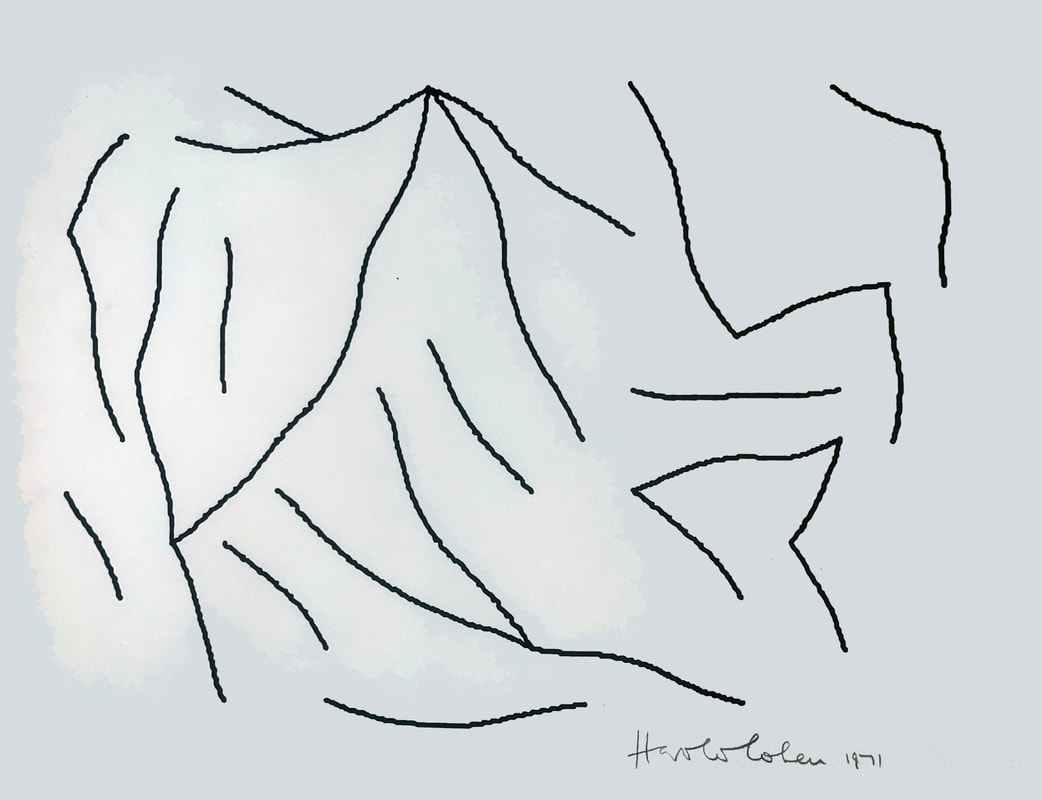|
|

AARON Drawing, Untitled (1971)
Harold Cohen (1928–2016) Harold Cohen was already a successful abstract painter when he first encountered computers in 1968 as a visiting professor at the University of California, San Diego. Captivated by the possibilities of this new medium, Cohen took a permanent position at UCSD and began developing a pioneering computer program called AARON. Over the next five decades—until his passing in 2016—he continuously refined and expanded AARON, making it one of the most famous AI-driven art programs ever created. His work helped establish the field of computational creativity, where researchers explore the nature of creativity through algorithmic processes. To be clear, this is not a print. It is a unique artwork conceived by a computer program and physically executed by a custom-built drawing machine. This piece represents one of the earliest computational works by a pioneer of generative art. To our knowledge, it is only the third machine-generated drawing by Cohen, created before 1972, to be offered for sale in this century. The artwork was generated by AARON and produced using a custom drawing machine equipped with a black casein applicator. It is executed on unmarked fine art paper of light cream stock with four straight edges. Cohen signed it in pencil in the lower right corner, dating it 1971, but without a title. This unique output from Cohen’s AARON program, circa 1971, holds a significant place in the history of computer-generated art. Its importance is further amplified by its provenance—it originated directly from Cohen and became part of the collection of esteemed artist and critic Sidney Tillim. This connection highlights a fascinating dialogue between artist, machine, and critic, illuminating the evolving intersection of art, technology, and conceptual thought in the late 20th century. Cohen’s AARON was revolutionary. It was more than a mere tool; it was a collaborator, challenging traditional notions of artistic creation. This drawing, produced by AARON’s custom-built drawing machine, embodies that groundbreaking vision. It is not a print but a singular artifact—a direct trace of AARON’s “hand,” demonstrating its ability to generate intricate and unique visual compositions. The act of applying casein to paper, guided by an algorithm, marked a radical departure from conventional artistic methods. The work’s presence in Sidney Tillim’s collection is particularly noteworthy. A key figure in the New York art scene, Tillim was deeply engaged with questions of mechanical reproduction, engraving, and printmaking—disciplines that probe the tension between originality and replication. He recognized the profound implications of Cohen’s work, understanding that AARON’s generative process represented a new mode of “mechanical” creation—one governed by code rather than traditional artistic tools. This drawing, therefore, is more than an artwork; it stands as a testament to Tillim’s prescient grasp of the shifting landscape of art and his appreciation for the intellectual depth of computer-generated imagery. The rarity of early AARON drawings from 1971 further underscores the significance of this piece. Some of Cohen’s earliest machine-generated works are housed in prestigious institutions, marking the birth of a new artistic medium. This drawing is a tangible link to Cohen’s initial forays into computer art—a period when he was laying the foundation for what would later be recognized as computational creativity. With its direct connection to both Cohen and Tillim, this piece offers a unique window into that pivotal moment. It is a conversation between artist, machine, and critic, captured on paper—an invaluable contribution to the history of art and technology. This particular drawing, dated 1971, was certainly produced by a drawing machine—evident from the indentations visible on the reverse side of the paper. While it bears similarities to works exhibited in Three Behaviors for the Partitioning of Space (January 1972), it remains distinct, signed with an earlier date. Notably, this piece was part of Cohen’s obscure first exhibition of computer art in 1971 and was acquired directly from the artist by Sidney Tillim. If you are interested in purchasing this historically significant work, please contact us at cavemanrobot@gmail.com. More about Sidney Tillim: Wikipedia |